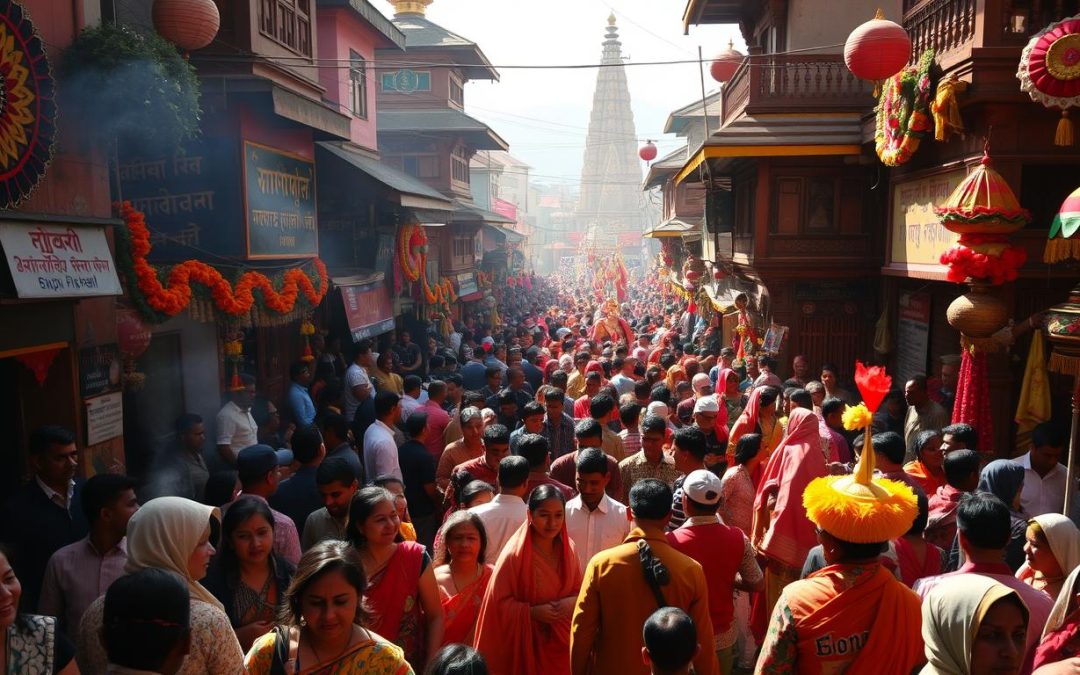Have you ever wondered what it’s like to experience a place where festivals are a way of life? Imagine a destination where nearly every week brings a new celebration, each with its own story, colors, and traditions. This is a place where culture thrives, and every day feels like a special occasion.
From the lively new year festivities to the deeply rooted rituals that honor history and community, these events are more than just parties. They are a window into the heart of a culture. Whether it’s the dazzling lights, the rhythmic dances, or the shared joy, each celebration offers something unforgettable.
Planning your visit around these events can make your trip even more memorable. But with so many options, how do you choose? Let’s dive into the highlights and discover what makes these celebrations truly one-of-a-kind.
Key Takeaways
- Experience a variety of vibrant and unique celebrations throughout the year.
- Learn about the historical and cultural significance behind each event.
- Plan your visit to coincide with major festivities for an unforgettable trip.
- Discover how these celebrations reflect the diversity of local traditions.
- Understand how festivals can impact travel plans and local businesses.
Experience the Rich Cultural Tapestry of Kathmandu Festivals
Discover how ancient traditions come alive in vibrant modern celebrations. These events are more than just gatherings; they are a reflection of a community’s identity and history. From the grand processions of Indra Jatra to the intricate rituals in Kathmandu Durbar Square, every celebration has a story to tell.
Discovering Historical Roots
The festivals you’ll experience today are deeply rooted in centuries-old traditions. Many of these events trace their origins to Hindu legends and historical events. For example, Indra Jatra, an eight-day festival, honors the king of gods and blends ancient rituals with modern festivities. It’s a perfect example of how the past continues to shape the present.
These celebrations are not just about fun; they are a way to honor history and preserve cultural heritage. The rituals performed during these events often have symbolic meanings, connecting people to their ancestors and their faith.
Modern Celebrations and Vibrancy
While the historical roots are essential, the modern-day celebrations are equally captivating. The streets come alive with music, dance, and colorful decorations. It’s a time when the entire community comes together, creating an atmosphere of joy and unity.
Whether it’s the rhythmic beats of traditional drums or the dazzling lights that illuminate the night, these festivals offer an unforgettable experience. They are a testament to how traditions evolve while staying true to their origins.
Understanding Nepali Festival Traditions and Calendars
The rhythm of celebrations is guided by a unique calendar system. The lunisolar calendar, also known as the Bikram Sambat, is the backbone of scheduling these vibrant events. Unlike the Gregorian calendar, it combines lunar and solar cycles, making festival dates shift slightly each year.
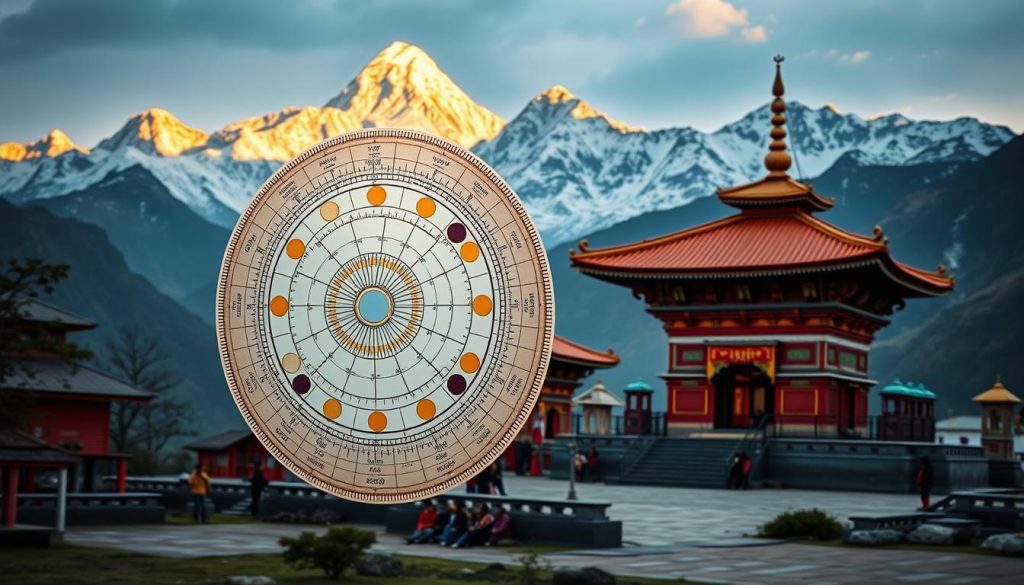
This calendar ensures that festivals align with specific lunar phases, adding a layer of cultural significance. For example, Dashain, the longest event, spans 15 days and is timed to coincide with the full moon. This lunar connection makes each celebration feel even more special.
The Lunisolar Calendar Explained
The lunisolar calendar is deeply rooted in tradition. It’s based on the movements of the moon and sun, creating a unique rhythm for celebrations. For instance, the year 2017 in the Gregorian calendar was 2074 in the Bikram Sambat. This difference highlights the distinct way time is measured here.
Festival dates change yearly due to lunar adjustments. This ensures that events like Tihar, also known as the festival of lights, always align with the right celestial phase. This connection to nature adds depth to every celebration.
Regional Variations You Should Know
Not all festivals are celebrated the same way across the country. Regional variations add diversity to these events. For example, Gai Jatra is primarily observed by the Newar community but has a presence nationwide. These differences reflect the rich cultural tapestry of the region.
Some festivals, like Teej, are predominantly celebrated by women. They gather to sing, dance, and honor Goddess Parvati. Similarly, Mahashivaratri sees thousands paying homage to Lord Shiva at sacred sites. These regional and gender-specific celebrations showcase the inclusivity of these traditions.
Understanding these variations can help you plan your visit better. Whether it’s joining a jatra procession or witnessing sacred rituals, these events offer a glimpse into the heart of the culture.
Kathmandu, Nepal: Top Festivals to Check Out When Visiting
Step into a world where every corner buzzes with energy and color during festive seasons. The streets come alive with vibrant parades, rhythmic dance, and glowing lights. You’ll find yourself immersed in a place where tradition and joy blend seamlessly.
Key sites like Kathmandu Durbar Square and Bhaktapur are at the heart of these celebrations. Here, you’ll witness lively rituals and processions that showcase the rich cultural heritage. The atmosphere is electric, with locals and visitors alike joining in the festivities.
Traditional Dances and Cultural Performances
One of the highlights of these events is the traditional dance. Performers dressed in colorful attire move to the beats of drums and flutes. These dances are not just entertainment; they tell stories of history and faith.
Cultural performances add another layer to the celebrations. From folk songs to theatrical acts, each performance reflects the spirit of the place. You’ll feel a deep connection to the culture as you watch these artistic expressions.
Local Variations and Tihar Festivities
Celebrations extend beyond the main cities to nearby Bhaktapur, where local variations add diversity. Each place has its unique way of honoring traditions, making every event special.
One of the most anticipated festivities is Tihar, also known as the festival of lights. Over five days, homes and streets are adorned with lamps and decorations. Each day has a specific focus, from honoring animals to celebrating sibling bonds.
| Festival | Duration | Highlights |
|---|---|---|
| Tihar | 5 days | Lights, animal worship, sibling bonding |
| Dashain | 15 days | Family gatherings, rice tika, full moon |
| Holi | 2 days | Color play, community celebrations |
These events are more than just celebrations; they are a way to connect with the nepali culture. Whether you’re watching a dance performance or lighting a lamp during Tihar, you’ll feel the warmth and enthusiasm of the community.
Celebrating Major Hindu Festivals in Kathmandu
Imagine standing amidst thousands of devotees, feeling the spiritual energy of a sacred celebration. These events are more than just gatherings; they are a testament to faith, tradition, and community. Two of the most vibrant and significant festivals here are Shivaratri at Pashupatinath and Holi, the festival of colors.
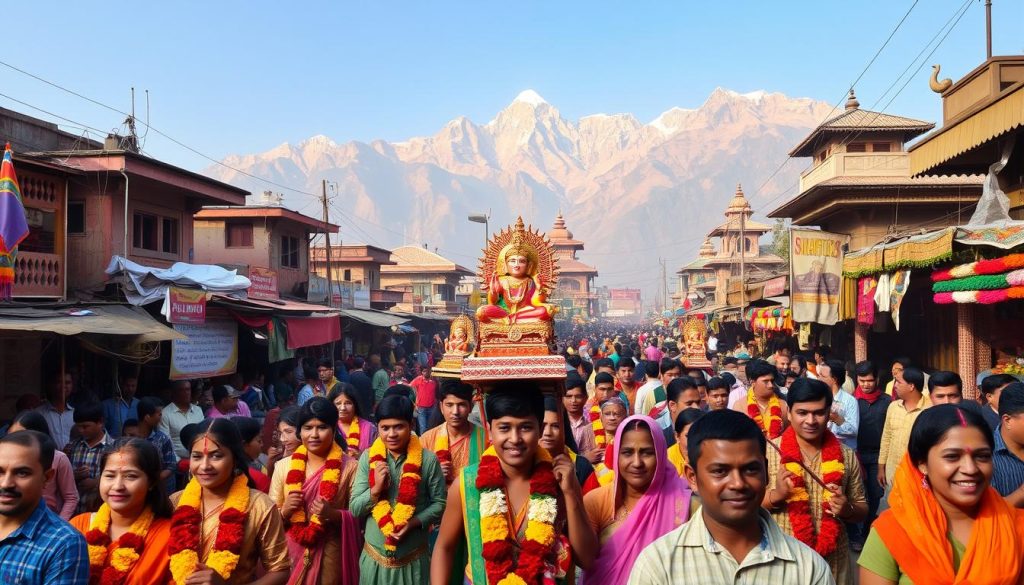
Shivaratri at Pashupatinath
Shivaratri, dedicated to Lord Shiva, is one of the most revered events in the Hindu calendar. The Pashupatinath temple becomes the epicenter of devotion, drawing pilgrims from across the country. On this day, devotees fast, chant prayers, and offer milk and flowers to the deity.
The atmosphere is electric, with sacred rituals performed throughout the night. Witnessing the sea of devotees, their faces lit by oil lamps, is a deeply moving experience. This festival is a perfect blend of spirituality and cultural heritage, making it a must-see event.
Holi – The Festival of Colors
Holi is a joyous celebration that marks the arrival of spring. The streets come alive with vibrant colors, music, and laughter. People of all ages gather to throw colored powders, dance, and share sweets. It’s a time when social barriers dissolve, and everyone comes together in unity.
To fully enjoy Holi, wear old clothes and protective gear, as the colors can be intense. The festival also includes traditional songs and dances, adding to the festive spirit. Whether you’re participating or observing, Holi is an unforgettable experience.
| Festival | Highlights | Best Time to Visit |
|---|---|---|
| Shivaratri | Night-long rituals, pilgrimages, spiritual energy | February |
| Holi | Color play, music, community bonding | March |
These festivals are not just celebrations; they are a window into the heart of Hindu culture. Whether you’re seeking spiritual enlightenment or a burst of joy, these events offer something for everyone.
Immersing Yourself in Newari and Buddhist Festival Experiences
Dive into a world where ancient traditions meet vibrant celebrations, creating unforgettable cultural experiences. These events are a beautiful blend of Newari and Buddhist influences, offering a unique glimpse into the heart of the community.
Yenya: The Heart of Celebrations
Yenya is a composite celebration that combines ancient Newari rituals with modern festive cheer. This event is deeply rooted in tradition, yet it brings a lively atmosphere that everyone can enjoy. The streets come alive with music, dance, and colorful decorations, making it a must-see experience.
During Yenya, you’ll witness a variety of rituals that honor the community’s heritage. These practices are not just about tradition; they are a way to connect with the past and celebrate the present. It’s a time when the entire community comes together, creating an atmosphere of joy and unity.
Exploring Losar and Buddhist Rituals
Losar, the Tibetan New Year, is another significant event that blends Buddhist traditions with festive celebrations. This festival is celebrated in Tibetan monasteries, where ritual performances and community gatherings take center stage. The atmosphere is filled with spiritual energy and cultural richness.
One of the highlights of Losar is the free, community-centric nature of the celebrations. Everyone is welcome to join in the festivities, making it a truly inclusive experience. The rituals performed during Losar are deeply symbolic, reflecting the essence of Buddhist teachings and the community’s way of life.
These festivals are more than just celebrations; they are a window into the soul of the culture. Whether you’re participating in Yenya or observing Losar, you’ll feel a deep connection to the traditions and the people who keep them alive.
Timing Your Visit: Key Festival Dates and Planning Tips
Planning your trip around local celebrations can transform your experience into something extraordinary. By aligning your travel dates with major events, you’ll gain a deeper connection to the culture and avoid missing out on unforgettable moments. Here’s how to make the most of your journey.
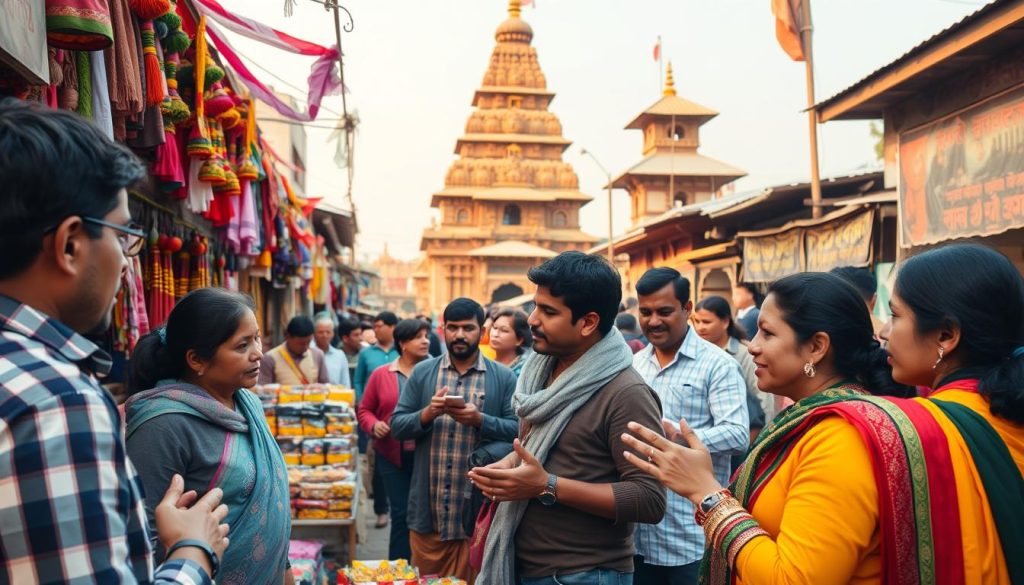
Planning Around Lunar-Based Festivals
Many celebrations follow the lunisolar calendar, meaning dates shift slightly each year. For example, Dashain, the longest festival, spans 15 days and aligns with the full moon. To synchronize your visit, check the festival calendar well in advance and mark key dates.
During major events, expect larger crowds and busier schedules. If you’re traveling with your family, consider arriving a few days early to settle in and explore the area before the festivities begin.
Practical Tips for a Smooth Trip
To avoid peak crowds at popular sites like Pashupatinath, plan your visits early in the morning or later in the evening. This strategy works especially well for child-friendly activities, ensuring a more relaxed experience for everyone.
Budget extra time for travel during major events, as roads and public transport can get busy. If you’re visiting during public holidays, look for quieter areas where you can enjoy the celebrations without the hustle and bustle.
Handling Closures and High-Traffic Days
Some businesses and attractions may close during major festivals. Plan ahead by checking local schedules and preparing alternative activities. For a family-oriented trip, consider visiting parks or cultural centers that remain open.
High-traffic days can be overwhelming, but they’re also part of the experience. Embrace the energy, but remember to take breaks and stay hydrated. With a little planning, you’ll navigate these days like a pro.
By timing your visit wisely, you’ll enjoy a seamless and enriching journey. Whether you’re exploring the area or diving into the festivities, these tips will help you make the most of every moment.
Local Insights: Navigating Cultural Etiquette at Festivals
Understanding local customs can make your festival experience more meaningful. Respecting cultural etiquette ensures a positive and enriching visit. From dress codes to behavior at sacred sites, these tips will help you connect with traditions and avoid unintentional missteps.
Dos and Don’ts at Sacred Sites
When visiting temples or sacred sites, dress modestly. Cover your shoulders and knees, and remove your shoes before entering. Always walk around stupas and temples in a clockwise direction, as this is considered respectful.
Photography restrictions may apply, so always ask for permission before taking pictures. Avoid touching religious artifacts or interrupting rituals. These practices show respect for the light of tradition and the community’s beliefs.
Dress Codes and Respectful Behavior
During festivals like teej, women often wear traditional attire. While visitors aren’t expected to dress the same, wearing modest clothing is appreciated. Bright colors are welcome, but avoid overly casual or revealing outfits.
Greet locals with a warm “Namaste,” a customary gesture that shows respect. If invited to a home, bring a small gift like sweets or flowers. These gestures foster goodwill and deeper connections.
| Etiquette Tip | Why It Matters |
|---|---|
| Dress modestly | Shows respect for local customs and traditions |
| Remove shoes before entering temples | Honors sacred spaces and practices |
| Ask before taking photos | Respects privacy and cultural sensitivities |
| Greet with “Namaste” | Demonstrates politeness and cultural awareness |
Navigating crowded areas in the city can be challenging. Stay mindful of your surroundings and avoid pushing or rushing. If you’re attending a festival in march, plan your visit early to avoid peak crowds.
Cultural sensitivity is key. Avoid discussing sensitive topics like politics or religion. Instead, engage in conversations about the festival’s significance. This approach fosters mutual understanding and enriches your experience.
Savoring the Festive Flavors: Food and Traditions
The aroma of spices and the sizzle of street food stalls fill the air during festive celebrations. Food is more than just sustenance here; it’s a way to honor traditions, connect with loved ones, and celebrate the richness of culture. From sweet treats to savory delights, every dish tells a story.
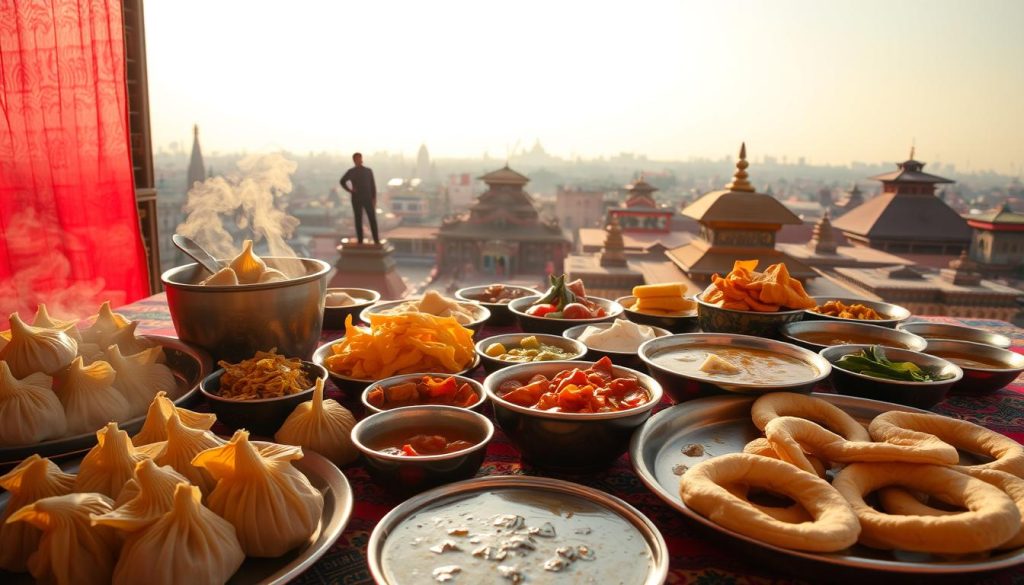
Traditional Nepali Delicacies During Festivals
During these vibrant events, you’ll find a variety of dishes that are deeply rooted in tradition. Sel Roti, a ring-shaped rice doughnut, is a staple during celebrations like Dashain and Tihar. Its sweet, crispy texture makes it a favorite among locals and visitors alike.
Another highlight is Chatamari, often called the “Nepali pizza.” Made from rice flour batter and topped with minced meat or vegetables, it’s a must-try for anyone exploring the street food scene. These dishes are not just food; they’re a celebration of heritage.
Food also plays a spiritual role. During festivals like Mahashivaratri, offerings are made to Lord Shiva, including milk, fruits, and sweets. These rituals symbolize devotion and gratitude, adding a deeper meaning to the culinary experience.
In some celebrations, the cow is honored as a sacred animal. Dishes like Yomari, filled with sweet or savory mixtures, are prepared to symbolize prosperity and goodwill. These traditions highlight the cultural significance of food in uniting communities.
From the bustling street markets to family kitchens, the festive flavors are a feast for the senses. Whether you’re savoring a plate of momos or enjoying a cup of traditional tea, every bite is a journey into the heart of the culture.
Beyond the Capital: Festivals in Surrounding Regions
Step beyond the bustling capital and uncover a world of unique regional celebrations. While the main city is known for its grand events, neighboring areas like Bhaktapur and Patan offer their own vibrant traditions. These festivals showcase the cultural diversity that makes this region so special.
Highlights from Bhaktapur, Patan, and More
In Bhaktapur, the Bisket Jatra stands out as a highlight. This festival, held in august, features grand chariot processions and lively street celebrations. It’s a time when the entire community comes together to honor their heritage.
Patan, known for its artistic traditions, hosts the Gai Jatra, a festival filled with humor and creativity. Participants dress as cows and parade through the streets, sharing stories and laughter. This event is a beautiful blend of tradition and modern expression.
During dashain, the longest festival, these regions come alive with unique rituals. In Bhaktapur, the focus is on the worship of Durga, the goddess of strength. Families gather to offer prayers and celebrate with feasts and music.
Traveling to these areas during festival season offers a deeper connection to the culture. Plan your visit in august to experience the vibrant energy of Bisket Jatra or join the Gai Jatra for a lighthearted celebration. These events are a testament to the region’s rich traditions and community spirit.
Conclusion
Exploring the vibrant celebrations of this region offers a unique window into its rich cultural heritage. From the lively processions in september to the glowing lights of november, each event tells a story of tradition and community. Planning your visit around the lunar-based calendar ensures you don’t miss these unforgettable moments.
Respectful behavior is key to enjoying these festivities. Dress modestly, ask before taking photos, and greet locals with a warm “Namaste.” These small gestures show appreciation for the culture and deepen your connection to the region.
Whether you’re honoring the dog during Tihar or witnessing ancient rituals, these celebrations are a testament to the community’s spirit. Take time to savor the flavors, join the dances, and immerse yourself in the joy of the moment.
Before you go, check the festival dates for september and november to align your trip with the most vibrant events. This region invites you to experience its cultural extravaganza, leaving you with memories that last a lifetime.
The above is subject to change.
Check back often to TRAVEL.COM for the latest travel tips and deals.
Here are some Tours & Sightseeing suggestions that might pique your interests!
